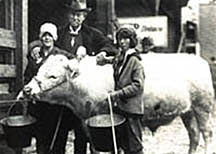More than 100 years strong
National 4-H History
In the late 1890's and into the early 1900's, 4-H programs began throughout the country in response to young people and their need for a better agricultural education. New agricultural production technology was being researched, but the farming community did not readily accept new ideas or techniques.
Boys and girls clubs were established to meet this need. Young people taught their families new techniques of corn growing, sewing, raising livestock, gardening, and canning that they learned in their 4-H clubs. This community club model engaged youth through "learning by doing." Most states organized clubs outside of schools with parents serving as volunteer leaders and educators providing appropriate educational materials.
No one individual is credited with originating the 4-H program but rather the program was founded through collective efforts of several individuals over the course of a few years.
Nevada 4-H History

Historic Photo
- Extension was founded nationally in 1914 as part of the federal Smith-Lever Act. In Nevada that year, its first employee, Norma Davis, was hired to give home demonstrations and supervise 4-H club work. The first State Fair was held in Fallon that year.
- By 1916, the present emblem, the 4-H clover, was well-known. Boys and girls between the ages of 10 and 20 were growing crops, raising livestock or poultry, making clothes, canning, keeping records and entering their projects for awards
- During World War I, enrollment dipped slightly, but 4-H Club Achievement Days were still held in Reno. Members displayed their clothing projects on lines between trees. Then, war saving stamps were awarded as prizes.
- In 1923, the first State 4-H Club Camp was held at the university's livestock farm south of Reno. Five years later, the first Junior Livestock Show was held near San Francisco, with Nevada beef as part of that event.
- In 1938, with the help of Mr. and Mrs. William Rabe of Gardnerville and the Nevada Farm Bureau, a permanent state 4-H Camp was established at Lake Tahoe. One year later, the first annual Nevada Junior Livestock Show was held in Reno.
- During World War II, 4-H club members joined the salvage campaign to help the war efforts. One club brought in enough scrap iron in its drive to build four tanks for the armed forces.
- In the post-war era, 4-H clubs flourished, maintaining many of the original agriculture projects, but also adding projects of interest to many of our urban youth. Today, nearly 50,000 young people each year in Nevada learn life skills in clubs, school and after-school programs.
As one of the first organizations that focused on providing youth with hands-on, learning opportunities, 4-H has a rich history of helping young people gain skills that they use throughout their lives. In 4-H, young people have fun, explore, discover and learn. Nevada 4-H'ers make new friends, develop life skills, become leaders and change their communities.
Nevada State 4-H Camp History
Extension began holding annual camps for 4-H club members in 1930 at University of Nevada, Reno facilities in Reno. Beginning in 1934, campers used the Boy Scout Camp at Zephyr Cove, Lake Tahoe for three years before the Nevada Farm Bureau leased the Skyland facility at Lake Tahoe for 4-H use.
Mr. and Mrs. William Rabe recognized that an annual camp would benefit Nevada's young people. For this reason, in 1938, they sold 30-acres of heavily-wooded, level ground to the Nevada Farm Bureau to establish a permanent 4-H Camp. In addition to the 30-acres of choice property which extended to the lake shore, the purchase included an easement to Lake Tahoe, two miner's inches (32,313,600 gallons) of water per day from Folsom Spring and an easement for the required pipeline to bring water to the camp.
On June 23, 1939, the Douglas County Farm Bureau inaugurated the campsite at its annual picnic, and on July 1, the first occupants arrived, 450 Seventh Day Adventist campers. The 4-H club groups camped at this site for the first time in August 1939 and have been camping there annually since that date.
On September 26, 1953, ownership of the camp was transferred to the State of Nevada under the direction of the Agricultural Extension Service and the University of Nevada, Reno Board of Regents. On December 30, 1947, an additional 3.29 acres of Lake Tahoe shorefront was deeded from D. Park to the State of Nevada, adding a beach to the property.
A new chapter in camp
A collaborative agreement among the University of Nevada, Reno Extension; Clark County; and Lincoln County has brought new educational and outdoor experiences to youth in southern Nevada.
The agreement, approved by the Nevada Board of Regents at its September 2023 meeting, provides a venue for a 4-H camp and youth educational activities in southern Nevada, similar to the 32-acre Nevada State 4-H Camp at Lake Tahoe.
The new 4-H Camp & Learning Center is located in the Lincoln County community of Alamo, about 100 miles north of Las Vegas. The 72-acre property was purchased from Leadership Possibilities International LLC. Previously used as a conference/retreat facility, the main building contains approximately 17,000 square feet with guest rooms, conference rooms and a commercial kitchen. The current layout contains 17 rooms that accommodate 72 guests, and has a variety of outdoor recreational amenities. For day use, the property can accommodate more than 200 guests.


